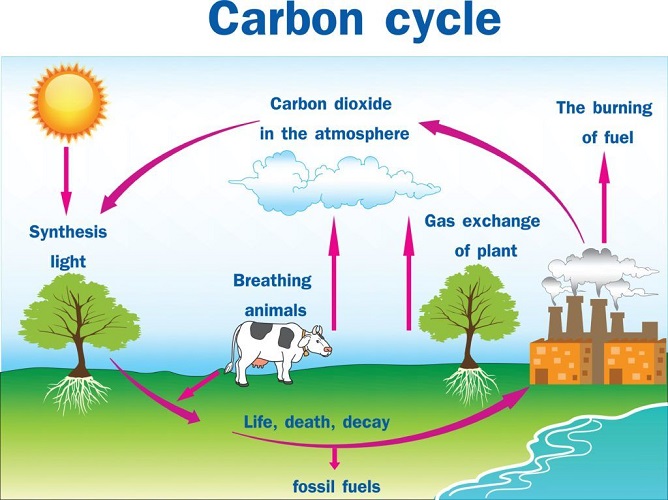What are biogeochemical cycles?
We explain what biogeochemical cycles or cycles of matter are and what types exist. The carbon, phosphorus and nitrogen cycle.
-
What are biogeochemical cycles?
It is known as biogeochemical cycles or cycles of matter to the circuits of exchange of chemical elements between living beings and the surrounding environment , through a series of transport, production and decomposition processes. Its name comes from the Greek prefixes bio , “life,” and geo , “earth.”
In the biogeochemical cycles both different forms of life (plant, animal, microscopic, etc.), as well as inorganic natural elements (rains, winds, etc.) are involved. They consist of perpetual displacements of matter from one area to others , thus allowing the recycling of the nutrients available in the biosphere.
By “nutrients” we mean all those elements or molecules whose presence in the organism of a living being is indispensable for the continuity of its existence and the reproduction of its species. It is usually between 31 and 40 different chemical elements, depending on the species, and is needed in different proportions. These nutrients can be of two types:
- Macronutrients . Whose presence in the body in its various compounds constitutes about 95% of the mass of all living organisms, such as carbon, oxygen, hydrogen, nitrogen, sulfur, calcium, etc.
- Micronutrients . Whose presence in the body of living beings is indispensable, but minority, sometimes simply traces of them, such as iron, copper, zinc, chlorine, iodine.
The biogeochemical cycles vary according to the properties of the element involved, and therefore involve different life forms as well.
-
Types of biogeochemical cycles
There are two types of biogeochemical cycle:
- Hydrologic . Those in which the water cycle or hydrological cycle intervenes , serving as a transport agent for the elements from one place to another. The water cycle itself can be included in this category, of course.
- Gaseous . Those in which the atmosphere intervenes to transport the chemical elements of the cycle, such as the nitrogen cycle.
- Sedimentary . Those in which the transport of the chemical element is given by sedimentation, that is, by its slow accumulation and exchange in the earth’s crust, such as the carbon cycle.
-
Importance of biogeochemical cycles
Since our planet is a closed system , from which matter does not come out (and to some extent it does not enter either) it is essential that vital chemical elements be recycled , otherwise they would be depleted and with them the possibility of a sustainable life.
In that sense, the biogeochemical cycles are the different mechanisms that nature has to circulate the matter of some living beings to others , thus allowing a certain margin to always be available.
None of the nutrients that a living being requires will be inside it forever, and eventually it must be returned to the environment so that they can be reused by others.
-
Cycle of nitrogen

One of the main biogeochemical cycles, in which prokaryotic microorganisms (bacteria) and plants fix nitrogen in their bodies, one of the main gases in the atmosphere. It is essential for various animal body compounds , including humans .
The cycle can be summarized as follows:
- Certain bacteria fix in their bodies the nitrogen gas (N 2 ) in the atmosphere, forming organic molecules that can be used by plants, such as ammonia (NH 3 ).
- Plants take advantage of these nitrogen molecules and transmit them through their tissues to herbivorous animals, and these through their tissues to carnivorous animals , and these to their predators , along the trophic chain .
- Eventually, living things return nitrogen to the soil , either through urine (rich in ammonia), or when they die and are broken down by bacteria , which fix the nitrogen-rich molecules, releasing nitrogen into the gas again.
-
Carbon cycle

The carbon cycle is the most important and complex of biogeochemical cycles, since all known life is composed without exception of compounds derived from that element. In addition, this cycle involves the main metabolic processes of plants and animals: photosynthesis and respiration .
The cycle can be summarized as follows:
- The atmosphere is composed of a significant volume of carbon dioxide (CO 2 ). Plants and algae capture it and convert it into sugars (glucose) through photosynthesis , using solar energy . Thus they obtain energy and can grow. In return they release oxygen (O 2 ) to the atmosphere.
- In addition to obtaining oxygen during their breathing processes, animals access carbon from plant tissues , in turn to grow and reproduce. But, both animals and plants, when they die they give the soil the carbon of their bodies , which through sedimentary processes (especially in the ocean floor, where the carbon is also dissolved in the waters) it is converted into various fossils and minerals .
- Carbon in its fossil or mineral state can last millions of years under the earth’s crust, undergoing transformations that throw matter as different as mineral coal, oil or diamonds. This matter will resurface thanks to erosion , eruptions and, especially, human labor: the exploitation of fossil fuels , the extraction of cement and other industries that throw tons of CO 2 into the atmosphere and both the ocean and the land other liquid and solid wastes rich in carbon.
- On the other hand, animals are constantly releasing CO 2 by breathing . In addition, other energy processes such as fermentation or decomposition of organic matter generate CO 2 or generate other carbon-rich gases, such as methane (CH 4 ) that also go into the atmosphere.
-
Phosphorus cycle

The phosphorus cycle is the last and most complex of the main biogeochemical cycles, since phosphorus is an abundant element in the earth’s crust, in mineral form, but that living beings require essentially, although in moderate amounts. Phosphorus is part of vital compounds such as DNA and RNA , and its cycle can be summarized as follows:
- Phosphorus comes from terrestrial minerals , which by erosion (solar, wind, water) are released and transported to various ecosystems. Human mining action can contribute to this stage as well, although not necessarily in a positive environmental way.
- Phosphorus-rich rocks provide nutrients to plants, which fix phosphorus in their tissues and, again, transmit it to other forms of animal life through the food chain. In turn, the animals return the excess phosphorus to the ground through defecation and the decomposition of their bodies, keeping the phosphorus in a cycle within the cycle among living things.
- However, phosphorus also reaches the sea , where the algae fix it and transmit it to the animals, but in this case the element is slowly deposited in the seabed, where various sedimentary processes will return it to the rocks that, later, in a very long and very long geological process, they will be exposed and will provide phosphorus to the biosphere again.




